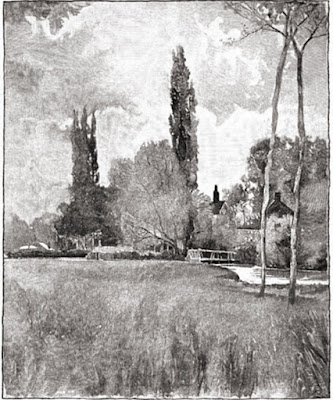Morris Hexathon 11: Merton Abbey by Ilyse Moore
Again we have a tessellation---one pattern piece---a triangle.
Merton Abbey by Becky Brown
The triangular pieces are flipped to get the rotating star, a sort of a mill wheel. I named it Merton Abbey for a mill on the Wandle River south of London.
The millhouse and wheel at Merton Abbey
The heart of a mill is the wheel, and the mill at Merton was the heart of the Morris enterprises for sixty years.In 1881, William Morris purchased this old textile factory. He'd decided that he had to weave, dye and print his own fabrics.
As in everything that interested him, he intended to master traditional techniques.He needed a mill for a traditional power source. Because he believed in preservation he bought one in need of rehabilitation rather than building a new operation, planning to "resuscitate the local industry in one of these beautiful villages."
As in everything that interested him, he intended to master traditional techniques.He needed a mill for a traditional power source. Because he believed in preservation he bought one in need of rehabilitation rather than building a new operation, planning to "resuscitate the local industry in one of these beautiful villages."
In 1940 Liberty and Company bought Merton mills, which they operated until 1972. The mill wheel still functions and a good day to visit is on a day when the shops are open.
Woman hand weaving carpet at the Merton Abbey mill.
Detail of a carpet from the Merton Abbey works.
In an 1884 letter to The Century magazine Morris explained his artistic philosophy at Merton:
I have tried to produce goods which should be genuine as far as their mere substances are concerned...tried, for instance, to make woolen substances as woolen as possible, cotton as cottony as possible, and so on; have used only the dyes which are natural and simple, because they produce beauty almost without the intervention of art....
Detail of a tapestry woven at the Morris works at Merton Abbey,
designed by Edward Burne-Jones and John Henry Dearle.
The warp threads are cotton, the weft silk and wool;
the dyes natural indigoes, madders and other vegetable colorings.
The Strawberry Thief from 1884 was one of the chintzes
printed at the Abbey.
Block Printing yardage by hand at Merton Abbey
The yardage above may be a first step in printing the Strawberry Thief.
Morris's daughter May remembered visiting "the long rickety printing shed to see where the handblocks were pressed and hammered on the chintz bit by bit with soft precision."
This design doesn't seem to have been published with a name so it has no BlockBase number.
Cut 6 of the triangle then flip the pattern over and cut 6 more.
A triangle cut in half
Pattern for an 8" Hexagon
(4" sides)
To Print:
- Create a word file or a new empty JPG file that is 8-1/2" x 11".
- Click on the image above.
- Right click on it and save it to your file.
- Print that file out 8-1/2" x 11". The hexagon should measure 4" on the sides
- Adjust the printed page size if necessary.
- Add seams when you cut the fabric.
Firecracker from The Quilt Room
A contemporary version for a Jelly Roll.
Another option---if you want to deal with 12 seams
meeting in the center!
An old reliable solution to that problem is to stick
a circle in the middle to cover any seam malfunctions.
For example: Endless Chain, BlockBase #272, which is similar.
The Wandle River at Merton.
One More Inspiration
Quilt by Angeline Paralee Hambleton Smith (1871-1949)
About 1930. Palo Pinto County, Texas.
Collection: The Briscoe Center
University of Texas at Austin
Quilt Index picture.


















I think I will sew two strips of my colors together and then lay the equilateral triangle of the seam to center the two parts. Seems easier to me. I'll let you know if it doesn't work. =)
ReplyDeleteDesertSky---That should work perfectly. you could use a stripe too.
ReplyDeleteI've been enjoying Morris Hexathon very much. So far 11 blocks finished, no need to say. Looking forward to seeing a new block every Saturday. Thank you for all of your efforts and inspiring stories, Barbara.
ReplyDelete